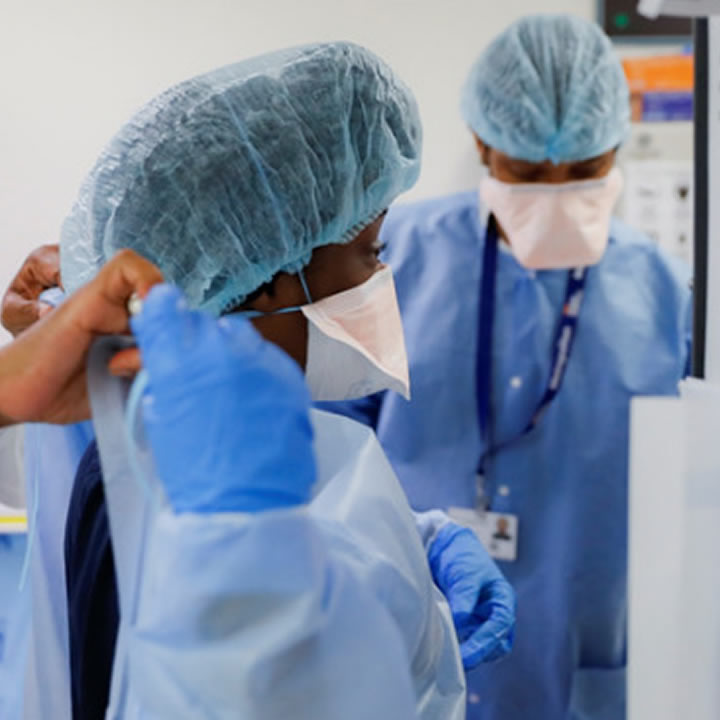The worldwide medical protective clothing market was worth $373.7 million back in 2019. The global outbreak of COVID-19 has brought an explosive growth of medical surgical masks and healthcare protective clothing in 2020. COVID-19 is under effective control by most of the countries around the world in 2021.
However, some of the countries were still in the deep water of COVID-19, and the demand for protective products remained strong. From 2020 to 2027, experts expect an increase of 7.4% CAGR (compound annual growth rate) for medical protective clothing.
Medical protective clothing plays a key role in the resistance to the coronavirus and is regarded as the most efficient source of protection for medical staff. Since it is so vital for medical staff, there must be strict regulations on their quality and standards. Only high medical quality protective clothing can help medical staff isolate themselves from the virus.
In this article, we will help you choose high-quality protective clothing by introducing what protective clothing is and the current specifications and standards of medical protective clothing.
What Is Medical Protective Clothing?
Protective clothing refers to the clothing used by medical personnel (doctors, nurses) and personnel (patients, laboratory staff, etc.) entering specific health areas to drastically reduce the risk for exposure to a range of different diseases and microorganisms (Hepatitis C (HCV), Hepatitis B (HBV), Ebola, Human Immunodeficiency Virus (HIV), COVID 19, etc.). Protective clothing possesses good barrier properties to resist the penetration of alcohol, blood, body fluid, air dust particles, bacteria, and viruses. It protects the health of relevant personnel effectively.
Protective clothing can be divided into isolation gowns and medical protective clothing. Medical protective clothing is superior to isolation gowns in terms of durability, protection grade, and protection performance.
Medical protective clothing refers to the clothing worn by personnel in a medical emergency, infectious disease area or electromagnetic radiation area, and other special areas. It belongs to personal protective equipment(PPE), mainly used to prevent the wearer from infection.
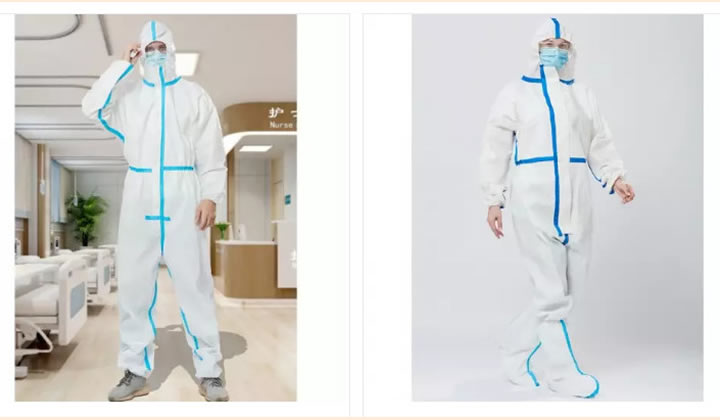
Isolation gown is the clothes worn by medical staff and patient’s families to visit patients. It belongs to two-way isolation, mainly to prevent the wearer from the transfer of microorganisms and body fluids in the case of a low-risk situation.
How to Select Medical Protective Clothing?
It is a way for users and purchasers to choose the best medical protective clothing by determining the appropriate label display for various performance and specifications of healthcare protective clothing.
Here are some elements that you can refer to when you are purchasing medical protective clothing.
Material
The common materials used for medical protective clothing are polypropylene textile adhesive fabric, new polyester fiber, polymer-coated fabric, SMS non-woven fabric, and polyethylene breathable film. Among them, the healthcare protective clothing made of polyethylene breathable film has the best effect of blocking penetration of bacterial particles and liquid penetration and provides great comfort for the wearer.
Polypropylene textile adhesive fabric ensures excellent anti-bacterial and anti-static protective clothing after anti-bacterial and anti-static treatment. Because of its relatively low cost, medical protective clothing made of polypropylene textile adhesive cloth got mass promotion as soon as it was released.
Therefore, in the purchase of wholesale medical protective clothing, clothing made of polypropylene textile adhesive fabric is a great choice for those who prefer low-cost. For achieving the best protective effect, it is wise of you to consider protective clothing made of polyethylene breathable film.
Barrier performance
Blocking viruses and bacteria for medical staff counts to be the biggest value of medical protective clothing, so the most critical factor in judging the quality standard of healthcare protective clothing is the barrier performance. Only by reaching the standards can medical protective clothing plays its greatest role. The barrier performance is evaluated by several factors, including liquid barrier performance, synthetic blood permeability, and microbial filtration.
The standards of different countries are not consistent, so we should pay close attention to the requirements of the local market for medical protective clothing. Only by following the relevant standard by your country can you effectively filter out some inferior medical protective clothing.
The standards for protective clothing in some major countries are as follows:
CE certification
The European standard for protective clothing is EN 14126:2003. According to the protection performance, the whole set of protective clothing is divided into six categories (from TYPE 1 to TYPE 6). The smaller the number, the higher the protection and TYPE 4 is recommended for medical use. For protective clothing certified by EN 14126:2003, the words “- B” will be added after the “TYPE” category (i.e. “TYPE 3-B”, “TYPE 4-B”, “TYPE 5-B”)
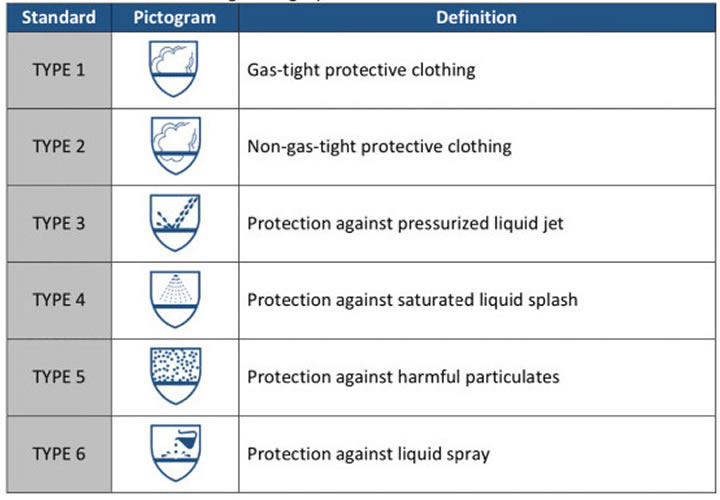
EN 14126:2003 includes 5 test methods to determine the protection class (the higher the class, the higher the protection level) against several specific biological hazards listed as the following:
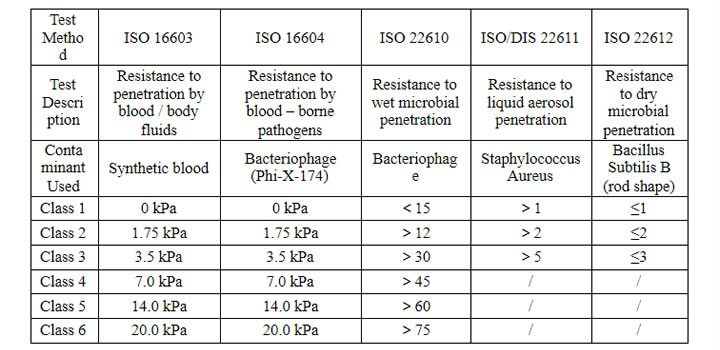
America: Protective clothing is divided into four levels according to the degree of protection in America, and Only Level 4 reaches the standard of medical protective clothing in this epidemic.
America adopts ANSI / AAMI PB70 as a standard for protective clothing, including four test methods to determine the degree of protection. The following lists the corresponding standards for four levels of protective clothing.
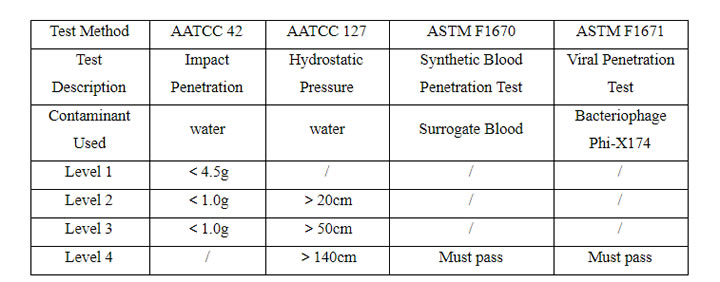
China: China adopted the GB 19082-2009 standard for medical disposable protective clothing, which is also divided into four levels according to the protection level. The higher the grade, the higher the protection level. The performance requirements of different levels of protective clothing are as follows:
- Hydrostatic Pressure: no less than 1.67 kPa (17cm H2O);
- Moisture permeability should not be less than 2500g / (M2 · d)
- Resistance to penetration by synthetic blood follows the standard of EN 14126:2003;
- The filtration efficiency of non-oily particles should not be less than 70%;
Japan: The personal protection standards in Japan are subordinate to the labor safety of T-class standards for medical safety appliances in national standards, among which the JIS standard is the most authoritative and important standard.
There are 45 standards involving protective clothing in JIS standards, but JIS T 8122:2015 (protective clothing for prevention of dangerous biological agents) combines chemical protective clothing standards with anti-infection protective clothing standards.
Therefore, the protective clothing that passes the JIS T 8122:2015 standard reaches the requirement of medical protective clothing in the epidemic.
Other factors
Whether the medical protective clothing has enough strength and dimensional stability is also needed to pay attention to when choosing it. The breaking strength is required to be no less than 45N, and the elongation at break no less than 30%. In addition, whether the medical protective clothing is comfortable or not is also vital for medical staff. The moisture permeability of protective clothing materials should reach over 2500g / m2 · d.
Conclusion
Picking out protective clothing when working in healthcare is a very important process. But, with a well-made product, you can drastically lessen the likelihood of exposure to microorganisms and pathogens to keep your health in check.
If you are looking for suitable, fully-tested medical protective clothing, then the ones by ZHENG KANG will do the trick. The medical protective clothing manufactured by them strictly follows the CE certification, considered as economical personal protection of preventing contaminant transfer and reducing the risk of exposure when working in a dangerous facility.
You get a top-quality disposable covering designed to protect your personal clothing when working with infected patients. Not only is this important for you, but for the patients as well.

